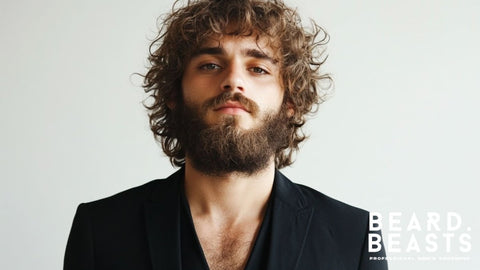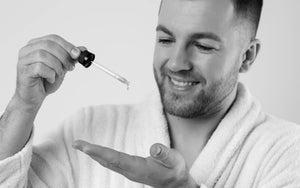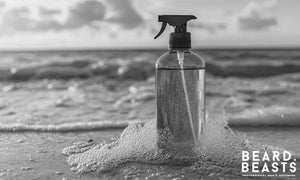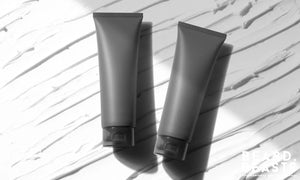10 Expert Tips for Managing a Curly Beard
Tired of battling a beard that seems to have a mind of its own? Curly beards, while undeniably stylish and unique, can be a real handful. From tangles and frizz to dryness and that "uneven growth" look, those beard curls come with their own set of challenges.
But don't worry, we've got you covered! This guide is packed with expert tips to help you manage and maintain your curly beard like a pro. Whether you're just starting your beard journey or you're a seasoned veteran looking for some advanced techniques, you'll find all the advice you need right here.
Get ready to unlock the full potential of your beard curls and transform that unruly mane into a source of pride and confidence.
Why Are Some Beards Curly?
Ever wonder why your beard has so much personality? It's all about those follicles! Unlike straight beard hair, which grows from symmetrical follicles, beard curls are the result of oval or asymmetrical follicles.
Think of it like this: straight hair grows out like a straight tube, while curly hair grows out like a bent or twisted tube. This causes the hair to grow in a curved or spiral pattern, giving you those awesome beard curls. And to make things even curlier, beard hair is naturally thicker and coarser than the hair on your head, which just adds to the effect.

Why Understanding Your Curls Matters
Knowing the "why" behind your beard curls is the first step to proper beard care. It helps you choose the right tools and products to either embrace your natural texture or tame those unruly curls. Think of it as learning your beard's language—once you understand how it works, you can work with it, not against it.
The Curly Beard Challenge
Okay, let's be real. While a curly beard can look amazing, it definitely comes with its own set of challenges. Here are a few you might be familiar with:
- Tangling: Those curls love to intertwine, leading to knots and tangles that can make combing a painful experience (and nobody wants that!).
- Dryness: The twists and turns in beard curls make it harder for your natural oils to reach the ends of the hair, leaving your beard feeling dry, brittle, and prone to beard split ends.
- Frizz: Dryness, combined with things like humidity, can turn your beard into a frizzy mess.
- Uneven Growth (or so it seems!): Even if your beard is growing evenly, those curls can create the illusion of patchy growth.

Don't Worry, There's Hope!
While these challenges are common, they're definitely not insurmountable. With the right grooming techniques and products specifically designed for curly beards, you can keep your beard healthy, soft, and stylish. A well-cared-for curly beard not only looks better but also feels more comfortable—and that's a win-win!
With a better understanding of your curly beard and its unique needs, you’re ready to explore expert tips that will help you manage and enhance your beard curls like a pro.
Expert Tips for Managing a Curly Beard
Ready to take control of those curls and create a beard that turns heads? Here are some expert tips to help you manage and enhance your curly beard with ease:
Tip 1: Choose the Right Beard Shampoo and Conditioner
Hydration is key when it comes to curly beard care. Regular shampoos, the kind you use on your head, are often too harsh for your beard. They can strip away natural oils, leaving your beard feeling dry, brittle, and looking like a bird's nest. Instead, opt for a beard shampoo specifically designed for curly hair. Look for moisturizing ingredients like argan oil, aloe vera, or shea butter. And don't forget the conditioner! A good beard conditioner will soften your beard, detangle those curls, and help define their natural shape.

Benefits:
- Prevents dryness and brittleness.
- Leaves your beard feeling soft and looking polished.
- Reduces frizz and enhances natural curl definition.
Pro Tip: Wash your beard 2–3 times a week to keep it clean without over-drying. On non-wash days, simply rinse with water and apply conditioner for a hydration boost.
Tip 2: Use a Beard Oil Regularly
Beard oil is a must-have for any curly beard enthusiast. Curly hair tends to lose moisture faster, which can lead to frizz, split ends, and a generally unkempt look. A high-quality beard oil will lock in moisture, tame frizz, and soften those curls. Look for oils with ingredients like jojoba oil, argan oil, or coconut oil.
Benefits:
- Keeps curls soft and frizz-free.
- Nourishes the beard and the skin underneath to prevent dryness and itchiness.
- Promotes a healthy shine and reduces breakage.
How to Use: Warm a few drops of beard oil in your hands and massage it evenly throughout your beard, from root to tip. Apply daily after showering to lock in moisture.
Tip 3: Tame Those Beard Curls with Beard Balm
Let's be honest, curly beards can have a mind of their own. Flyaways and unruly strands are a common struggle. That's where beard balm comes in. It's a moisturizer and a styling product all in one! Beard balm typically contains hydrating ingredients like shea butter and beeswax, which provide a light hold and help define your curls.

Benefits:
- Provides light control for a neat, structured look.
- Helps define curls and keep them in place.
- Protects against dryness and environmental damage.
How to Use: After applying beard oil, take a small amount of balm and rub it between your palms to warm it up. Then, apply it evenly throughout your beard, shaping your curls as you go.
Tip 4: Detangle with the Right Tools
A Curly beard is notorious for tangles, which can be a real pain (literally!). But don't worry, the right tools can make detangling a breeze. Ditch the regular comb and opt for a wide-tooth beard comb or a beard brush with natural bristles. These tools will glide through your curls more easily, preventing breakage and those dreaded knots
Benefits:
- Prevents knots and breakage.
- Makes detangling faster and less painful.
- Ensures even distribution of products.
How to Use: Start detangling from the tips of your beard and work your way up to the roots. Always detangle after applying beard oil or conditioner to minimize resistance.
Tip 5: Master the Art of Trimming
Trimming a curly beard requires a bit more finesse than trimming a straight beard. The goal is to keep your beard looking neat and balanced without messing up your natural curl pattern. Use sharp beard scissors or a quality beard trimmer with adjustable guards. And remember, a little goes a long way! Curly hair tends to shrink when it dries, so trim small amounts at a time to avoid over-cutting.

Benefits:
- Keeps your beard looking sharp and professional.
- Prevents split ends and promotes healthy growth.
- Maintains your beard's natural shape.
Pro Tip: Trim your beard when it's completely dry. Wet beard curls can be deceiving! If you're unsure about trimming your own beard, consider visiting a barber who specializes in curly beards.
Tip 6: Keep Your Curly Beard Hydrated
Keeping your beard hydrated is crucial, especially if you live in a dry climate or spend a lot of time outdoors. In addition to using conditioner, consider adding a leave-in conditioner or hydrating beard butter to your routine. These products provide continuous moisture throughout the day, keeping your beard soft, manageable, and itch-free.
Benefits:
- Prevents dryness and brittleness.
- Keeps curls soft, smooth, and manageable.
- Reduces the risk of split ends and frizz.
How to Use: Apply a leave-in conditioner or hydrating spray after your morning grooming routine. Reapply as needed throughout the day, especially in dry or cold weather.
By incorporating these expert tips into your routine, you can transform your curly beard from a wild mane into a tamed masterpiece. But great beard care goes beyond the basics, so let's explore some long-term strategies to keep those curls looking their best.
Long-Term Curly Beard Care Strategies
By now, you're probably feeling like a curly beard expert (and you are!). But maintaining an awesome beard is an ongoing journey, not a destination. Here are some long-term strategies to ensure your beard stays healthy, manageable, and stylish for years to come:
Tip 7: Develop a Daily Routine (and Stick to It!)
Consistency is key when it comes to caring for your curly beard. A daily routine will keep your beard clean, hydrated, and looking its best. Here's a simple routine to follow:
- Morning: Start with a few drops of beard oil to hydrate and reduce frizz. Then, use a wide-tooth comb to detangle and distribute the oil evenly.
- Midday (Optional): If you live in a dry climate or your beard needs an extra boost, use a hydrating beard butter or leave-in conditioner.
- Evening: On wash days, gently cleanse your beard with a curly beard shampoo and follow up with conditioner. On non-wash days, just rinse with water. Finish with a small amount of beard balm to lock in moisture and keep those curls in check.

Benefits:
- Maintains softness and hydration throughout the day.
- Reduces tangling and frizz.
- Enhances the natural definition of your curls.
Tip 8: Show Your Beard Curls Some Love at Night
Believe it or not, your beard needs some TLC even while you sleep! Tossing and turning on a rough pillowcase can cause friction, leading to frizz, dryness, and even breakage. Switch to a satin or silk pillowcase—your beard (and your skin!) will thank you.
Benefits:
- Minimizes frizz caused by friction.
- Preserves your beard's moisture levels.
- Prevents breakage and tangles.
Tip 9: Feed Your Curly Beard from the Inside Out
A healthy beard starts from within! Make sure you're eating a balanced diet rich in vitamins and minerals that promote strong, hydrated hair. Key nutrients include:
- Protein: Found in eggs, lean meats, and fish, protein is essential for hair growth and strength.
- Omega-3 Fatty Acids: Found in salmon, walnuts, and flaxseeds, these healthy fats promote hydration and shine.
- Biotin and Zinc: Found in nuts, seeds, and leafy greens, biotin and zinc support hair thickness and prevent breakage.
And don't forget to drink plenty of water! Staying hydrated is crucial for both your beard and your overall health.

Benefits:
- Promotes faster, healthier beard growth.
- Reduces brittleness and breakage.
- Enhances the natural shine and elasticity of your beard.
Pro Tip: Consider taking a multivitamin or a beard-specific supplement to ensure you're getting all the essential nutrients.
Tip 10: Don't Underestimate the Power of a Barber
Even with a solid routine, a regular visit to a barber who specializes in curly beards can make a world of difference. They can shape your beard without ruining your curl pattern and offer personalized advice on products and techniques.
Benefits:
- Keeps your beard looking sharp and well-maintained.
- Prevents over-trimming and uneven shaping.
- Helps you learn advanced grooming tips.
How Often to Visit: Aim for a trim every 4–6 weeks.
Pro Tip: When choosing a barber, look for one with experience in curly beard grooming. Check out their online portfolio or ask for recommendations.
Conclusion: Master Your Curly Beard
Managing a curly beard doesn't have to be a constant battle. With the right knowledge and a bit of patience, those curls can become your most stylish feature. Remember, healthy curls start with understanding your beard's unique needs and using the right products and techniques.
Don't let dryness, frizz, or tangles hold you back! By choosing the right shampoo and conditioner, embracing beard oil and balm, and protecting your beard while you sleep, you can keep those curls looking their absolute best.
A well-maintained curly beard is a bold statement of confidence and individuality. So, embrace those curls and enjoy the journey! With these expert tips, you're well on your way to transforming your beard into a source of pride and a head-turning style statement.
Ready to take the next step? Explore products designed for curly beards, book an appointment with a skilled barber, or refine your grooming routine today. Your curly beard deserves the best care!




